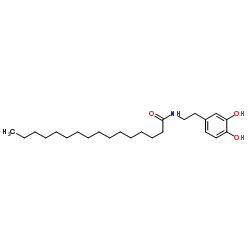136181-87-8
| Name | N-[2-(3,4-dihydroxyphenyl)ethyl]hexadecanamide |
|---|---|
| Synonyms |
Palmitoyl dopamine
HMS3268B22 N-[2-(3,4-Dihydroxyphenyl)ethyl]hexadecanamide Hexadecanamide, N-[2-(3,4-dihydroxyphenyl)ethyl]- BML3-G01 N-Palmitoyl Dopamine PALDA |
| Description | N-Palmitoyl dopamine (PALDA) is a endogenous, long-chain, linear fatty acid dopamide, which is inactive on TRPV1. N-Palmitoyl dopamine displays 'entourage' effects on endovanilloids N-arachidonoyl-dopamine (NADA) and anandamide[1]. |
|---|---|
| Related Catalog | |
| In Vitro | PALDA (0.1-10 μM), the EC50 of N-arachidonoyl-dopamine (NADA) is lowered from approximately 90 to approximately 30 nM. The effect on intracellular Ca2+ by another endovanilloid, N-arachidonoyl-ethanolamine (anandamide, 50 nM), is also enhanced dose-dependently by PALDA. PALDA also acted in synergy with low pH (6.0-6.7) to enhance intracellular Ca2+ via TRPV1[1]. |
| References |
| Density | 1.0±0.1 g/cm3 |
|---|---|
| Boiling Point | 589.5±40.0 °C at 760 mmHg |
| Molecular Formula | C24H41NO3 |
| Molecular Weight | 391.587 |
| Flash Point | 310.3±27.3 °C |
| Exact Mass | 391.308655 |
| PSA | 69.56000 |
| LogP | 7.22 |
| Vapour Pressure | 0.0±1.7 mmHg at 25°C |
| Index of Refraction | 1.515 |
